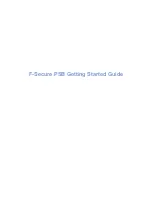
Chapter 9.
109
Using Certificate System
Using any Certificate System has basic tasks such as editing the configuration file, starting and
stopping the server instance and Console, opening web services, and locating logs. This is explained
in more detail in the
Certificate System Administrator's Guide
.
9.1. Starting the Certificate System Console
The CA, DRM, OCSP, and TKS subsystems have a Java interface which can be accessed to perform
administrative functions. For the DRM, OCSP, and TKS, this includes very basic tasks like configuring
logging and managing users and groups. For the CA, this includes other configuration settings such as
creating certificate profiles and configuring publishing.
The Console is opened by connecting to the subsystem instance over its SSL port using the
pkiconsole
command. This command has the format:
pkiconsole https://server.example.com:
admin_port/subsystem_type
The
subsystem_type
can be
ca
,
kra
,
ocsp
, or
tks
. For example, this opens the DRM console:
pkiconsole https://server.example.com:10445/kra
If DNS is properly configured, then an IPv4 or IPv6 address can be used to connect to the console.
For example:
https://1.2.3.4:9445/ca
https://[00:00:00:00:123:456:789:00:]:9445/ca
9.2. Starting, Stopping, and Restarting an Instance
The Certificate System subsystem instances can be stopped and started using system tools on Red
Hat Enterprise Linux. For example:
service
instance-name
{start|stop|restart}
The instance name for default subsystem instances is usually
pki-
instance-id
, such as
pki-ca
.
9.3. Starting the Subsystem Automatically
Red Hat Enterprise Linux 5.3 has a tool called
chkconfig
which manages the automatic startup and
shutdown settings for each process on the server. This means that when a system reboots, some
services can be automatically restarted.
chkconfig
also defines startup settings for different run
levels of the server.
chkconfig
is explained more in the Red Hat Enterprise Linux documentation,
such as
the Deployment Guide
1
.
Certificate System subsystems can be managed by
chkconfig
, so this tool can set whether to restart
subsystems automatically. By default, every Certificate System subsystem instance is turned off at
every run level in the system, meaning instances must be started and stopped manually. This can be
changed by resetting the configuration in
chkconfig
to
on
. For example, this automatically restarts
Red Hat Directory Server, Administration Server, and the CA:
1
http://www.redhat.com/docs/manuals/enterprise/RHEL-5-manual/Deployment_Guide-en-US/s1-services-chkconfig.html
Содержание CERTIFICATE SYSTEM 8 - DEPLOYMENT
Страница 5: ...v 9 5 7 Shared Certificate System Subsystem File Locations 119 Index 121 ...
Страница 6: ...vi ...
Страница 18: ...8 ...
Страница 32: ...22 ...
Страница 50: ...Chapter 3 Installation and Configuration 40 9 Optionally change the subject names for the certificates ...
Страница 70: ...60 ...
Страница 104: ...94 ...
Страница 114: ...104 ...
Страница 118: ...108 ...
Страница 132: ...122 ...














































